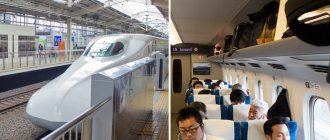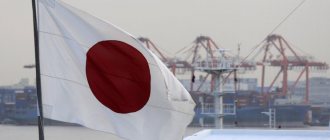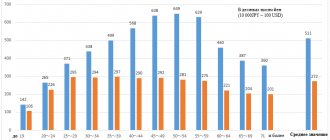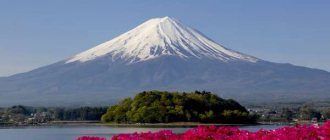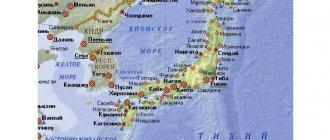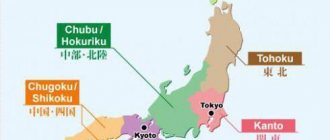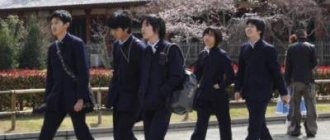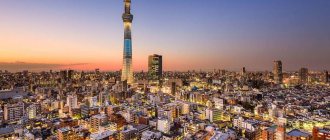The opinion that the economy of the Land of the Rising Sun is in decline today is erroneous. One glance at the map of the Japanese transport system is enough to convince you of this. Transport in Japan is required to cope with serving more than 100 million people on a very small piece of land and is therefore very highly developed. The country is investing heavily in infrastructure. Today there are about 1.2 million km of roads and more than 27 thousand km of railways, the incredible intertwining of which not every Japanese can understand.
General information
A single network of high-speed toll roads and about 250 Shinkansen bullet trains connect major cities, and dozens of railway companies compete in regional and local transportation markets.
Japan's largest domestic airport, Haneda, is the busiest in Asia. The country's main air gates - Narita, Kansai and Chubu international airports - regularly appear in rankings of the largest in terms of traffic.
Through Japan's largest port, Nagoya, with a cargo turnover of over 210 million tons per year, Japanese goods, including cars, are distributed en masse around the world.
Public transport in Japan is more developed than anywhere else and includes complex systems of subways, trains, buses, monorails, trams and ferries operated by different owners. It is the latter circumstance that greatly complicates the lives of passengers. You have to buy several tickets, since there are no single tickets for all operators.
In Tokyo, you can use non-personalized reloadable PASMO and Suica cards. You can use them to pay for travel on the subway, trains and some buses. The system automatically calculates the tariff and debits funds from the card, which must be replenished regularly.
From September 1, 2021, a Welcome Suica travel card with a validity of 28 days, created specifically for tourists, is available throughout the country. Also for 1,590 yen (child costs 800 yen) you can purchase a one-day Tokyo 1-Day Ticket (Tokyo Free Kippu or Tokyo Combination Ticket), which provides unlimited travel on the Tokyo Metro, Toei, Toden tram, most Toei buses, and the Nippori Line and all Japan Railways (JR) lines within the urban area.
Train Station
The railway station building in Kyoto was built in 1997 according to the design of Hiroshi Hara. In my opinion, the author was let down by the mixture of many topics in one building. It lacks a coherent idea, as does the entire city of Kyoto as a whole. But there are interesting angles.
There is a garden on the roof and signs warning you to beware of black crows, which may attack to take your food.
View of the city of Kyoto from the roof of the station
Japanese subway
The metro in Japan is represented in nine major cities: Fukuoka, Kobe, Kyoto, Nagoya, Osaka, Sapporo, Sendai, Tokyo, Yokohama, Hiroshima. It is considered the most convenient way of transportation.
The fare depends on the travel distance, tariffs and the number of operators servicing individual lines. For example, on Tokyo Metro lines it is 160 yen, and on the Toei municipal subway it is 170 yen.
The cost of a trip to a specific station is indicated on the metro line map. There are no through routes; at the final stops you have to get off and buy another ticket or pay extra at the yellow Fare Adjustment machines.
Here you need to insert the ticket into the slot - and the amount that needs to be paid will be displayed on the board. After paying extra, you can go through the turnstile.
Signs on a blue background direct to the platforms, and on a yellow background - to the exits. The stations are equipped with controllers at the entrance and exit to the cars. By the way, the latter are equipped with the latest technology.
Boarding on the metro is carried out one by one, along special markings on the floor of the platform. There is free Wi-Fi here, but cell phone conversations are prohibited. Stations are announced in Japanese and English. Train intervals are 5 minutes.
On some lines, women-only carriages run during peak hours. As a rule, they are located at the tail of the train and are marked with special stickers.
The metro and how to navigate it
The Japanese metro is different from how we imagine it in Russia. Most of the routes run on the surface, and the network is so extensive and complex that in the city center it is not uncommon to see five trains from different branches rushing in different directions at the same time.
There are subways in many Japanese cities, except Tokyo, these are Osaka, Nagoya, Yokohama, Kyoto, Kobe, Sapporo, Fukuoka, Hiroshima, and some others. The principles of their design are similar; they are distinguished from each other only by their scale. The largest, most extensive and complex systems are in Tokyo and Osaka. They are the most overloaded.
For residents of major Japanese cities, the subway is the best and most reliable way to travel. Taking the metro is a little more expensive than taking buses, but when you take into account the speed and reliability, as well as the extremely extensive network of stations, it becomes clear that it really is the most optimal route.
Numerous branches in different versions connect a variety of areas of megalopolises; for greater convenience, intermediate hubs are provided where the main lines of the metro, commuter trains, and buses converge. Above I have attached a map of the Tokyo metro for clarity.
Travel advice . The colors of the branches help you navigate inside. The signs at stations and on trains are clear and contain a lot of useful information. The arrival of trains at stations, as elsewhere in the world, is announced by radio. However, do not be embarrassed by the fact that you hear Japanese speech. Just remember the name of the station you need and be careful. If you hear it at the entrance to the station, it means you should get off. If the name sounds after the words “Tsugi wa,” then it’s yours next.
Tickets can be purchased from vending machines or ticket offices. To purchase at the cash register, just name your station; at the machine, find it in the menu, which is also in English. I’ll talk about travel tickets a little below. As for the cost of a standard trip on the subway, in Tokyo, for example, depending on the distance, it ranges between 1.8-3.1 dollars / 180-310 yen.
It’s quite easy to find your way around the metro – the main thing is not to be afraid of the hieroglyphs. All relevant information is duplicated here in English. To understand the overall picture, it is enough to remember that the signs on a blue background direct you to the platforms, and on the yellow background - to the exits.
We get into the metro through well-known turnstiles, then, following the signs, we exit onto the platforms. You must keep your ticket until the end of the trip; you will need it to exit at the destination station.
Japanese bus
City buses are not popular in Japan, although the network is well developed and allows you to quickly get to the main attractions.
At the stops there is an information board with comprehensive information about the routes in English. Boarding is through the front door, and exit is through the middle or rear door.
The fare is paid at a special machine next to the driver. If you don’t have a pass, you can buy a ticket from him by naming your stop. The amount can be found out by the display located above the windshield.
The machine has slots for coins (with openings for 25 and 50 yen does not accept) and bills, a compartment for change and a reader for travel cards. A day pass purchased in advance can simply be presented to the driver. To exit, you need to press the button on the handrail.
The buses have air conditioning and free Wi-Fi.
The schedule and location of stops can be found on the official website of the bus company. The cost of travel is relatively low. For example, in the central zone of Tokyo it is 120–150 yen ($1.2–1.5).
In other cities, communication is most often organized according to the principle of transport zones. Schemes and approximate cost of the trip can be found at bus stops and on buses.
Major bus carriers offer multi-day passes. For example, the 10,000 yen Willer Express Pass allows you to travel on the company's buses for three days without any travel restrictions.
This is a very inexpensive, but not so fast way to travel. Flights are day and night.
Taxi
I have already said that in general city transport is organized very competently and actually provides for any needs of citizens. Despite this, taxis are extremely popular both among tourists and the Japanese themselves.
In Japan, this is the mode of transport where you will find the most differences from the usual patterns.
- Firstly, this concerns the appearance of drivers. They are all dressed in dark suits and white shirts, wearing ties, their shoes are in perfect condition, and they are wearing white gloves!
- The interior of cars will be completely unexpected for most - it is simply a kingdom of lace; the seats, headrests, and armrests are covered with lace capes.
- No attempt to open the passenger door on your own will be successful. It can only be opened by the driver and only from the inside. This applies to both boarding and disembarking upon arrival. So be patient.
- Finally, as in many other countries, you can tell if a car is available by looking at the icon behind the windshield. However, in Japan, the red color of the icon means that the taxi driver is free, and the green color means that the taxi driver is busy. This fact causes numerous discussions and debates; one of the humorous theories even connects it with the fact that in Japan, traffic is on the left. However, most likely, the explanation here is much simpler and more practical - the red light is better visible in the flow of traffic.
There is no single template for indicating that a vehicle is a taxi in Japan. You can distinguish the car by the sign on the roof, but there is no word TAXI or checkers on it. Most often, such signs are marked with the carrier’s logo.
You can hail a car on the street; all you have to do is raise your hand. In addition, taxis can be found at specially designated parking areas, most often located in areas favored by tourists, such as Akihabara, Shinjuku, Roppongi, Ikebukuro. Regular, familiar taxi stands are also located near metro stations, large department stores, and in entertainment areas. Queues at taxi ranks in big cities are not uncommon, especially in the morning and evening during rush hours.
You most likely will not be able to talk to a taxi driver during the trip; most of them speak only Japanese. I have already noted on various occasions that taxis in Japan are quite expensive. Below are some sample prices:
- Landing and first 2-3 km – from 6 dollars/600 yen.
- Every next 500 m – 1 dollar/100 yen.
- Traffic and parking costs $1/100 yen for 2 minutes.
- Waiting for a taxi is 1 dollar/100 yen for 2 minutes.
In the evening, in large cities, the coefficients come into force; after 10 pm the markup will be 20%, and after 11 – 30%. Cars are equipped with meters; they record travel time, mileage, and cost of the trip. You can pay for the trip either by card or in cash. However, you should keep in mind that drivers most often do not have change, so when planning a taxi trip, take care of this in advance. You don't leave tips in taxis.
Trams and trolleybuses: a Japanese attraction
Trolleybuses have never been common in this country. Today, from the windows of the only trolleybus in Japan, only the walls of the tunnel are visible, since it has become underground.
As of 2021, the two existing lines are completely exotic. Trolleybuses from Tateyama Kurobe Kankō Company and Kansai Electric Power Company are used to transport tourists to Mount Tate in the Japanese Alps. These are ultra-modern, well-equipped and very comfortable cars. A ticket for passengers over 12 years old costs 8,290 yen, for children ─ 4,150. It can be purchased at the ticket office at the beginning of the route.
There are very few trams in Japanese cities. Tram systems exist in Sapporo, Hakodate, Kamakura, Toyohashi, Toyama, Kyoto, Osaka, Okayama, Hiroshima, Matsuyama, Kochi, Nagasaki, Kumamoto and Kagoshima.
Tokyo's once-excellent tram system has given way to rapid transit. There are only two routes left in the center and one in the suburbs ─ Kamakura. By the way, the last one, “Enoden”, with its antique trailers, looks more like a tourist one.
There are no conductors on the tram. The fare is 170 yen for an adult and 90 yen for a child. Travel is paid at the entrance. The machine does not issue tickets or change.
With the wind!
A taxi driver stands out from other types of transport in Japan. He wears a formal business suit. Definitely dressed in an ironed shirt. He wears spotless white gloves on his hands. The look is complemented by a tie. The driver's shoes are always in perfect condition. Foreign tourists who use taxi services for the first time are surprised by the abundance of lace that decorates car interiors.
Headrests, armrests and even seats are covered with openwork knitted capes. You won't be able to open the car door yourself. This is the driver's privilege. Therefore, you need to wait a little until the lock is unlocked.
The rules of public transport in Japan are strikingly different from European norms. The green color of the icon on the windshield of the car means that the taxi is busy. Red signals that the driver is free. Special areas for boarding taxis are equipped in the largest areas of Tokyo and other metropolitan areas. In the provinces, cars are caught right on the roadway.
Despite the comfort, taxis are still inferior in popularity to the Japanese subway. Cars often get stuck in traffic jams. Sometimes the number of waiting passengers exceeds the number of available vehicles. In these cases, queues accumulate in the parking lots.
Railway
Rail transport is the main means of transportation. The seven companies of the Japan Railways (JR) group cover most of the needs. Japanese trains always run exactly on schedule, and the high-speed Shinkansen 500 and N700 series reach a maximum speed of 300 km/h.
The company provides services: super-express, courier, express with sleepers and reserved seats. The fare depends on the distance and class of carriage. If you use the window (midori-no-madoguchi), you can purchase tickets for carriages of various classes over long distances.
In cities, tickets for local lines can be purchased from special vending machines located at stations.
The Japan Rail Pass, intended for travelers, can only be purchased outside of Japan. The ticket entitles you to unlimited travel on JR trains, buses and ferries, with the exception of the Nozomi Super Express.
Buying tickets
The cost of train travel in Japan consists of two parameters. The price is affected by distance, and the category of composition is also important. A trip from Osaka to Tokyo by express will cost 12,000 rubles. The route from the capital to Sapporo, the length of which is 830 kilometers, is estimated at 20,000 rubles. The most popular type of rail pass in Japan is the JR Pass.
Each subscription has a validity period and an unlimited number of trips. Green cards require first class travel. All others are designed for budget-conscious passengers. Children also need to purchase a card. Special subscriptions have been developed for them. Students over 11 years old need to buy a regular ticket. Tourists need to remember that the subscription is personalized. It is issued on the transport company’s website, and then the printed coupon is exchanged at any JR office.
The travel pass can be issued for seven days, two weeks or 21 days. The cheapest one will cost about 35,000 rubles, the most expensive costs almost 80,000 rubles. This pass allows you to use all express trains except Mizuho and Nazomi. Plus, it is accepted on ferries calling at the port of Miyajima, as well as on trains heading to Narita Airport.
A worthy alternative to JR is Seishun 18. This subscription is not personalized. It will not always be possible to arrange it. It is only valid during holiday periods, which fall in March, April, July, August and September, December and January. The validity period of Seishun 18 is exactly five days. It is accepted on all express trains except the Shinkansen. The ticket price is 12,000 rubles. You can buy a subscription at the terminals and ticket offices of stations.
The standard fare for a trip between Nikko and the Japanese capital is 1,300 rubles, between Yokohama and Tokyo is 500 rubles. To get from Kamakura to Tokyo you need to pay 900 rubles. The journey from Osaka to Kyoto will cost 500 rubles.
There are several other passenger programs operating in Japan. The list of the most popular ones includes “Kansai”, “Sanyo”, “Kuishu”, “Hokkaido”. Discounts are provided not only to children under 12 years of age, but also to pensioners and students upon presentation of the appropriate documents. The average speed of trains in Japan is 200 kilometers per hour.
Monorail
Monorail transport in Japan is recognized as promising. Systems with a total length of over 100 km operate in eight large cities. The largest is located in Osaka (length 23.8 km). There are also in the provinces, for example, on the island of Okinawa.
This is a fully robotic complex that eliminates the work of personnel, including drivers. Tickets can be purchased at stations from ticket offices or ticket machines. Travel cards are valid on some routes (information is indicated at the stations). Fare ranges from 80 to 500 yen.
Monorail in Japan
Monorails in Japan exist in many cities; for example, in addition to Tokyo, such systems are common in Osaka and Okinawa. However, they play the main role in transport communications in Tokyo.
The Tokyo Monorail is a fully automated train system with no drivers in the cars. The monorail lines do not intersect with the metro and commuter trains; they have their own stations and tickets, which must be purchased separately.
In the west of Tokyo there is the Tama Toshi Monorail line, in the city of Chiba, a Tokyo suburb, there are two Chiba Urban Monorail lines.
The most popular monorail is the Tokyo Monorail, which connects the city with Haneda Airport. The terminal stations of the monorail are Hamamatsucho Station and Haneda Airport Terminal 2 Station.
Aviation transport
With more than 90 airports, Japan is considered one of the most convenient countries for travel. Airfare is set by carriers but regulated by the government.
Two national carriers (JAL and ANA) and several regional carriers, including low-cost carriers serving strictly defined domestic destinations, compete with each other, reducing ticket prices. For example, Japan Airlines and ANA offer passes for several domestic flights (usually no more than 5) at a cost of 7,000–8,000 yen (about 4.5 thousand rubles). Tickets can be purchased at the airport ticket office or online.
Sea transport
The ferry in Japan is the main way to travel from island to island. Water transport is represented by tourist pleasure boats of many private companies.
In Tokyo, ferry services are operated by Tokyo-Wan Ferry. Routes and schedule are presented on.
One-way ticket costs from 720 yen, return ticket ─ 13,230 yen. A child ticket costs 360 and 660 yen respectively. Children under 5 years old are carried free of charge. Tariffs are presented on the official website.
Tickets can be purchased at the box office or through vending machines at the piers. PASMO cards are accepted for payment.
Take in the Tokyo skyline from the futuristic Tokyo Cruise water bus. Schedules and prices for lines can be found on the company’s official website. You can also use a special calculator on the site. Ships depart from the main city piers.
They are competed by Tokyo Mizube Cruising Line cruises, which depart around the clock. An interactive route map will help you navigate and choose the appropriate line.
You can take a cruise from Yokohama on the Keihin Ferry Boat. An adult ticket here costs 1,200 yen, a child ticket costs 600 yen.
There is an alternative!
Monorail is another popular mode of transport in the country. Japan's monorail railways have covered most populated areas. They are also available in Okinawa. In the capital, this type of transport is represented by fully automated trains, which are controlled by intelligent systems. They have no drivers or stewards. This type of transport is considered one of the safest.
Despite its similarity to the subway, in Japan the monorail is a completely independent transport complex. Tickets are sold at robotic terminals and ticket offices located on boarding platforms. When entering the carriage, tourists strive to take the first seats. The panoramic windows of the salon offer futuristic views. The most popular excursion route runs through Tokyo Bay and leads to Odaiba Island, a man-made landmass.
Taxi in Japanese
Taxis in Japan are among the most expensive in the world. In central Tokyo, you need to pay over 400 yen per kilometer.
Ordering a car costs 300–400 yen, 1.5 minutes of downtime ─ 80 yen, night surcharge ─ 20%. Payment is accepted in cash and by cards (local banks only). But here they can deliver a passenger to an address written in English.
If the red light is on in the upper left part of the windshield, the car is free and can be stopped by raising your hand. It is worth remembering that the left rear door opens and closes automatically.
Transport Japan
The transport system in Japan is one of the most advanced in the world, serving more than 100 million people annually. Today it is the most organized and effective among the advanced states. Thanks to this, traveling around the Land of the Rising Sun is a great pleasure.
What types of transport are developed in Japan?
The island state owns modern models of water, air and land transport. Thanks to the developed railway network and 1.2 million kilometers of highways, everyone can get to anywhere in the country.
Photos of trains and water buses in Japan are surprising to the inhabitants of the globe. It seems that this technique is from the future, but not from the present. It is here that you can see the latest models of railway and water technology, mostly domestic developments. Seeing all this, many tourists wonder: what type of transport is the least developed in Japan? The answer is simple: there is no such thing.
But it is worth mentioning that there is a type of transport that is completely absent - inland waterway. There is simply no need for it yet.
How did Japan solve the problem of transport communication between the islands?
Japan consists of four large and 6,848 small islands. Given this geographical location, the question of transport connections between all populated areas of the country arises. The solution was the ferries that now regularly run between Tokyo, Osaka and Kobe. They are located in the southern part of the archipelago. The main ports of the islands are Hokkaido and Kyushu. Other islands are connected by tunnels and bridges.
Buses of Japan
Buses are a key component of road transport in Japan. In every city, the network of this public transport is organized at a high level. The local population is well versed in it, but tourists should know a few basic points:
- All routes operate from 7:00 to 21:00. Flights serving remote areas operate on a different schedule - from 5:30 to 23:00.
- At each stop there is a bus schedule indicating routes and route numbers. But only in most cases this information is provided in Japanese.
- Another difficulty is the lack of route numbers on buses. The Japanese government is confident that the name of the bus flight, made in hieroglyphs, is quite enough.
- For many Europeans, buses may seem uncomfortable: narrow seats and low ceilings. But the Japanese themselves feel quite comfortable.
- You need to pay the fare at the exit.
- In Tokyo, fares are fixed, meaning the price does not change depending on the number of stops you travel. In other cities it’s the other way around. The ticket indicates the number of the stop where you boarded, and at the end of the journey the board displays how much you must pay.
Intercity buses are comfortable: wide seats, reclining backrests and the ability to stretch your legs. Therefore, tourists who want to save money on a hotel buy a ticket for an overnight flight to another city, and wake up in a new place in the morning.
Railway transport
Rail transport is very popular in Japan, as it allows free movement between almost all cities in the country. The main intercity routes run along the southern and northern coasts of Honshu. In addition to the main railway network, there are roads on the major islands of Kyushu, Hokkaido and Shikoku. Today, all the main routes are duplicated by roads, so tourists always have a choice of how to get to this or that city.
Many of Japan's commuter trains are high-speed because they travel on magnetic levitation. This is an example of the development of high-speed rail. On electrified highways, train speeds reach 200-300 km/h. Traveling on such a train will be fast, and if you want to get from one part of the country to another in a matter of hours, this is a great option.
Looking at a map of the transport geography of Japan, you will notice that all railway lines are painted in a certain color. And to make it even easier for passengers to navigate, all trains are painted in the color of the line they are following. The price of a train ticket to Tokyo is $1.45; fares for other destinations can be found before departure at the station. On each of them there is a board indicating the ticket price in national currency.
As for trams, they are the most suitable form of public transport in Japan for tourists. The cost of one trip is $1.30, and figuring out where the station is and which route you need is easier than with a bus. But there is a significant disadvantage - there are trams only in Nagasaki, Kumamoto and on the islands of Kyushu, Shikoku and Hokkaido.
Tokyo also has a metro system, which today ranks first in the world in terms of annual passenger traffic, namely 3.217 billion people. The capital's metro consists of 13 lines and 285 stations. The total length of the tracks is 286.2 km. The subway fare is about $1.50.
Among other things, in Japan there is a magnetic levitation train or “flying train”, which is not a classic railway transport, since it does not run on rails. The advantages of this modern type of transport are that it can reach speeds of up to 500 km/h. Currently, such trains are not intended for passenger transportation. Presumably, “flying trains” will start operating on the route only in 2027.
Monorail transport
In Tokyo there is also a type of transport whose lines do not intersect with the subway and railway. The monorail has 16 stations. The compositions are found only on them. The rail can be located both above and below the train.
The first monorail transport appeared in 1957. The trains are fully automated, meaning none of them have a driver. The fare for this type of transport starts from $1.35.
Car rent
Among all types of road transport in Japan, car rental[/anchor] is the least popular. In order to rent a car, you must have an international driver's license and Japanese insurance (JCI). In addition, driving a car in Japan is quite difficult, since the country drives on the left. Add to this ignorance of the language and road signs, some of which can only be found here. There are constant traffic jams on the roads, and there is a real shortage of parking spaces, so it is extremely difficult to enjoy driving here.
Taxi in Japan
Tokyo taxis are some of the most expensive in the world, so if you're looking for the cheapest form of transport in Japan, taxis should be ruled out. For every 280 m you will need to pay $0.82, and for every 2 minutes 15 seconds add another $0.80. Given the congestion on the roads, any trip will last at least 15-20 minutes, so passengers will have to pay a considerable amount.
It is important to know several features of this type of transport in Japan:
- You should only get into the car from the left side, as the right side is blocked.
- All doors are automated.
- At night, a taxi driver has the right to refuse to take a passenger without giving a reason.
- If the yellow light on the car is on, it means that the taxi is responding to a telephone call and there is no point in stopping it.
Air transport in Japan
Aircraft in the country operate domestic and international flights. The largest airports are Haneda, Narita in Tokyo and Kansai in Osaka. Haneda is the busiest airport in the world. But even this was not enough for densely populated Japan, so a new runway station was recently built. Thanks to this, the number of passengers increased by almost 420 thousand. There are also 15 helicopter stations in the country.
Until 2000, prices for air tickets were set by the government, but private airlines have been doing this for more than 15 years. At the same time, you should not be afraid that the cost of tickets is exorbitant, since the government of the country has reserved the right to veto prices if they are inflated.
Water transport in Japan
In Japan, sea transport is used only to reach the small islands located in the southern part of Japan. Ferries can also be used to get to Russia, South Korea, China and Taiwan. There are currently 108 ferry routes in Japan. Route lengths vary from 25 minutes to 2 hours 45 minutes. You can take bicycles, motorcycles and cars on the ferries. In this case, the fare will increase in proportion to the weight of the cargo.
Japanese car rental
Car rental is possible in almost all large and medium-sized cities, as well as at airports and main railway stations.
Russians require international licenses, but local rental companies and police do not recognize them because they drive on the left.
Obtaining a local license requires a Russian driver's license with a certified translation at the consular department of the Russian Embassy, a passport, passing an exam and a vision test.
There are a lot of rental companies, so the prices are the world average. Mandatory conditions include at least 1 year of driving experience and return of the car with a full tank within the strictly specified time frame.
Buses in Tokyo
Bus stops are often located near the train station exit. The route system is quite confusing, and the Japanese themselves use this type of transport infrequently. Unlike the subway or train, the wait at an open-air stop is long by Japanese standards (from 20 minutes to an hour). If you still choose a bus, then it will greet you with comfort. True, foreigners are surprised why the Japanese sit until the last minute, and then, when the bus stops, get up from their seats and go to the exit. For this purpose, there is even a notice on the bus instructing you to act this way. Payment is made upon boarding with the driver.
